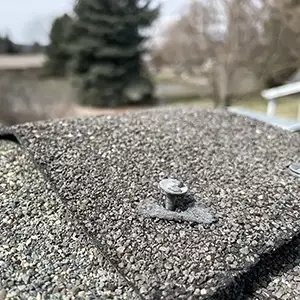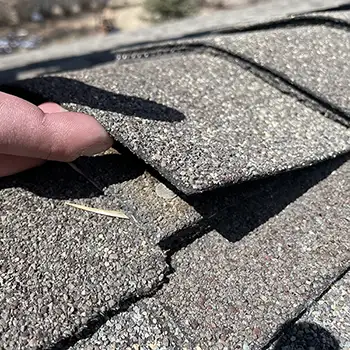Spotting roof hail damage can be tricky. It depends upon the roof material, the size and velocity of the hail stones, among other factors. Sometimes the damage is obvious. However, sometimes it’s not. What’s more, sometimes the damage is urgent and needs attention right away. Other minor damage can wait. Below are a few tips on how you can spot roof hail damage. If you notice any of the following, you should address it as soon as possible.
If you did have a hail storm come through your neighborhood and would like a professional roofer to inspect your roof for free to determine if you have hail damage, contact us. We will let you know if there is any damage or if your roof is ok. If there is damage, we can also give you a free estimate.

Cosmetic vs Functional Roof Hail Damage
Cosmetic roof hail damage is damage that only affects the appearance of your roof, it poses no real functional harm. An example of cosmetic roof hail damage is a dented metal roof. A dent only affects the appearance of the roof, it doesn’t affect the performance of it. Functional hail damage, on the other hand, affects the function or performance of your roof. An example of functional roof hail damage is a cracked roof, such as cracked roofing tiles. If your clay, concrete, or wood shake roof is cracked, water can seep into the crack and onto your roof deck. This can lead to a roof leak.
You can spot roof hail damage by looking for the following:
- Black Spots on Asphalt Shingles
- Loose Fasteners
- Loose Roofing Material, Such as Shingles or Metal
- Dents or Cracks in Metal Roofing
- Dents or Cracks in Flashing or Vent Boots
Black Spots
One easy way to spot roof hail damage is to look for black spots. When a large enough hail stone strikes asphalt shingles or stone-coated steel shingles, the shock dislodges the granules leaving the black asphalt beneath exposed. These looks like black spots about the size of a coin. If you notice these exposed black spots on your asphalt shingle or stone-coated steel shingle roof, you should have your roof inspected right away. The primary purposes of these granules is to protect your roof from UV radiation. Without them, the asphalt beneath them will prematurely dry out and crack, and result in a roof leak.

Loose Fasteners
Fasteners are the screws or nails that secure your roof material down to the roof deck. Asphalt shingles and tiles use nails, while metal roofs use screws. In a hail storm, hail stones can loosen fasteners. Loose fasteners can lead to a roof leak. If you notice loose screws or nails on your roof, you should drive them back down and cover them with construction sealant once your roof is dry and before the next rain or hail storm.

Loose Roofing Material
Hail storms can also cause roof material, such as asphalt shingles, to become loose. During a hail storm, all those hail stones striking your roof cause lots of small vibrations. Those can cause roofing material to become loose. Loose roofing material can be torn-off in the next high wind storm which lead to missing roof material. If you notice loose asphalt shingles or any other roofing material, you should secure it back down by the appropriate method. Most loose shingles require a little construction sealant underneath them. If you are unsure how to reseal your particular roofing material, contact us for a free roof inspection and estimate.

Dents or Cracks in Metal Roofing
If you have a metal roof and a hail storm has come through your neighborhood, you might notice dents in your roof, if the hail stones were large enough. Dents in a metal roof are only cosmetic and pose no functional harm. However, large enough hail stones can not only dent a metal roof, but also crack it. Hail stones can also crack old metal roofs. If you have a standing seam metal roof, we do not recommend you step foot on it, for your own safety, as metal roofs are slick. Instead, contact us for a free metal roof inspection. We will let you know if your roof is damaged or if it’s good to go.
Dents or Cracks in Flashing or Vent Boots
Flashing and vent boots can also get dents or cracks. While you’re inspecting your roof, don’t forget to inspect the flashing and vent boots for damage. Flashing is often found between your roof covering and chimney. Vent boots are a cone-shape shield around the base of pipes. Large hail stones can also damage these. If you notice damaged flashing or vent boots, you should probably contact a roofing professional to have them repaired or replaced. Cracked or unsealed flashing and vent boots are a sure sign of a leaking roof.
Roofs Most Resistant to Hail
- Standing Seam
- Stone-Coated Steel Shingles and Shake
- Concrete Tiles
- SBS Modified Asphalt Shingles
- Impact Resistance Asphalt Shingles
Roofs Least Resistant to Hail
- Clay Tiles
- Wood Shake
The Bottom Line
If a hail storm has recently come through your neighborhood, it’s always best to contact us for a free roof inspection. We have a dedicated roof inspector that knows how to spot roof hail damage. He’s more than happy to come to you and let you know if your roof has any damage or if it’s ok. If he notices any damage, if you like, we can put together a free roof repair or replacement estimate.
